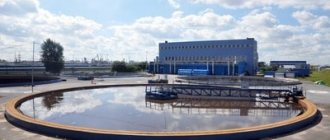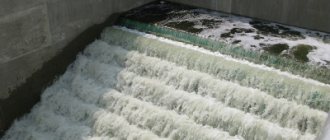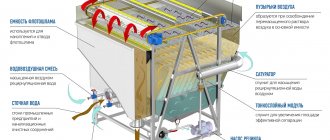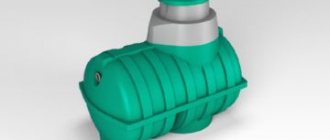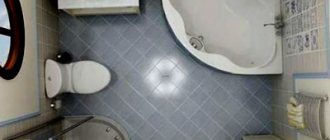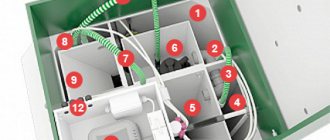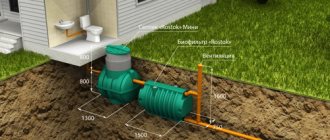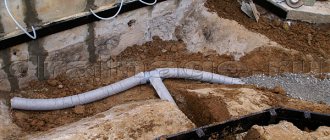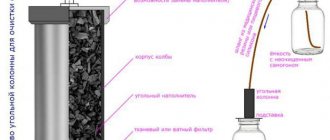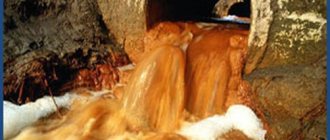People have always sought to settle and live where there is water. However, in the process of life, people pollute the water and it becomes unsuitable for drinking, washing, or watering plants. Fortunately, there is a solution to this problem - these are water purification systems that allow you to use water several times.
In this article, we will look at the features of choosing and using water purification systems that can be installed on the site for water supply to your country house.
Why use purified water?
Russia is one of the richest countries in terms of natural resources. We have plenty of everything, including water. Therefore, many homeowners ask the question: why, in fact, purify the water? It’s easier to use, drain and get a new one from a well or borehole.
However, it should be understood that the resources that nature gives us are far from eternal. Over the years, wells dry up and boreholes become clogged. And this is simply irrational, having a source of clean fresh water and the possibility of its repeated use, use it only once. Many people in the arid regions of the planet are simply envious of the fact that you water your garden beds with clean well water or wash your car.
Our environment is deteriorating every year. That is why today many domestic and foreign scientists are everywhere creating new ways to save precious natural resources, including water. And it’s no longer a secret that wastewater treatment systems can achieve significant savings in water consumption by households.
Project: conditions and factors
How to make a sewer system in your own private house? The construction of any facility begins with a project. When drawing up an autonomous sewerage project for a household, it is necessary to take into account many factors:
- Depth of groundwater;
- Features of climatic indicators (amount of precipitation and temperature regime of the territory);
- Soil features;
- Relief and area of the site;
- The frequency of presence of residents in the house (residential structure for seasonal, periodic or permanent residence);
- Number of residents;
- Intensity, estimated water consumption per resident, taking into account plumbing fixtures.
In addition, it is imperative to take into account all current norms, rules, requirements of the joint venture on the installation of sewerage in private houses (SP 32.13330.2018 “Sewerage. External networks and structures”, replacing SNiP 2.04.03-85).
Depending on the above factors, the most suitable sewerage option is selected, characterized by varying degrees of performance.
What types of wastewater treatment systems are there?
Based on the principle of operation, wastewater treatment systems can be divided into three groups:
- Biological;
- Physico-chemical;
- Mechanical.
Physico-chemical systems include: the chlorination method and saturation of water with ozone.
In practice, wastewater treatment systems use a combination of combinations of these methods with varying levels of pollution, and when treating water, so-called “averageizers” are used. What it is? Let's talk about this further.
Review of popular waste disposal devices
The industry produces septic tanks of various models, which differ in performance and principle of operation. To select and install the most optimal waste disposal device, you need some experience and knowledge. takes full responsibility for all concerns regarding the selection and installation of local treatment facilities. GC New Place for a deep cleaning septic tank, for example, carries out installation within one day. Septic tanks are divided into two groups – volatile and non-volatile.
Volatile septic tanks are called aeration stations - these devices perform deep wastewater recycling and produce water purified up to 98%.
They use different types of bacteria. For the life of aerobic bacteria, oxygen is required, the supply of which is provided using compressors.
How is water purified?
Before the main water purification cycle begins, the wastewater undergoes rough treatment, which reduces the load on the basic components of the system.
For better water purification they also use:
- Membranes;
- Various grilles and filters;
- Shredders of large and solid particles and so on.
The homogenizers we talked about above are accumulators in which liquids are mixed before purification, and the output is a homogeneous mixture. This makes the operation more uniform and the wastewater is treated more efficiently.
What is water purified from and how? To answer this question, it is worth considering the design of wastewater treatment systems in more detail.
To begin with, there can be a wide variety of contaminants and particles present in wastewater. They are divided into:
- Colloidal particles, the size of which can reach from 0.1 microns to 0.001 microns;
- Insoluble impurities that contain large particles (f more than 0.1 mm);
- Molecular dispersed solutions, which consist of soluble particles.
It happens that the wastewater contains only a certain group of pollutants. For example, this could be petroleum products, or biological waste from farms. In this case, special structures from appropriate structures are installed for wastewater treatment.
We also note that often the drainage treatment system is installed individually, since different drains have contaminants of a very different nature, and not every source needs to be cleaned.
Thus, only the most dangerous wastewater requires the use of chemicals or physical and chemical treatment methods. Whereas for some natural conditions the use of chemicals is unacceptable, since the place where wastewater is discharged may be contaminated and the soil poisoned. This will also be associated with unnecessary costs of funds. Therefore, chemical cleaning is used only as a last resort.
Filtration capacity of soil for organizing water drainage from a septic tank
Installation of structures for underground filtration is possible only on certain types of soil. Sand and sandy loam absorb water well and have a high filtration capacity (m/day), so they are perfect for placing filter wells. Clay is characterized by minimal moisture permeability. Loams with clay inclusions of about 10–30% are something intermediate between the first soil option and the second. Moreover, heavy loamy soils are often unsuitable for creating filter systems, while medium and light soils pass liquid quite well.
More accurate information about soil qualities is usually obtained through engineering geological exploration (well drilling). However, there are ways to independently determine soil permeability. For example, at the construction site of a future treatment plant, the earth is excavated to a depth just below the base of the proposed sump. Then the pit is filled with water several times and the average rate of its absorption by the soil is measured, converting hours or minutes per day.
Having the area of the flooded surface of the pit (in sq. m) and its volume (in cubic m), the approximate filtration coefficient is determined: V/S × T = m³/m²×day = m/day. After this, the load permissible for a unit area of the filtering surface of the treatment plant is calculated (measured in liters per day), according to the indicators in Table No. 1 of the STO NOSTROY 2.17.176-2015 standard.
Operating principle of treatment systems
Wastewater treatment is carried out in 5 stages:
- First, small organic contaminants, as well as large mechanical particles, are retained and deposited by special filters and membranes;
- The second stage is associated with the need for binding and decomposition of substances that remain after the first stage;
- At the third stage, special cleaning methods are used, for example, removing contaminants from animals or petroleum products;
- At the fourth stage, wastewater requires additional treatment in specialized facilities;
- And finally, the fifth stage is the disposal of dry residue, which is collected after wastewater treatment. As we have already said, the dry residue often contains compounds such as nitrogen, phosphorus and various mineral fertilizers, which can be successfully reused in agriculture.
What are settling filters?
Wastewater treatment processes involve the use of settling filters, which are a mandatory element of these systems. The sediment filter makes wastewater treatment a simple matter and forces the pollutants present in the water to settle out.
The principle of operation of a wastewater sump is in the presence of anaerobic bacteria, which, during their life in the cesspool, utilize various impurities, processing them into useful substances, which we discussed above.
Recycling bacterial sludge for cesspools is one of the popular types of business for many enterprises in our country. The size of the settling tank is about a quarter of the total size of the wastewater treatment system. Due to the work of bacteria, which do all the necessary work, it is possible to keep the volume of the sump small.
Typically, pollutants contained in wastewater account for up to 10 percent of the total volume of water. Sometimes, these figures are much smaller, amounting to only 5 percent. To improve the environmental situation in Russian villages and cities, it is necessary to properly design sedimentation tanks, thereby saving the budget of the locality. That is why the design of wastewater treatment plants is the primary task of environmental specialists, since it increases the safety of our lives and saves money.
The final element of any wastewater treatment system is a deep biological wastewater treatment station. These structures house bacteria that interact with oxygen in the air and decompose biological and organic waste.
In the same way, due to bacteria, sewage drains are cleaned and metal oxides are created. Bacteria also power many wastewater treatment plants in chemical plants, and even wastewater from the oil industry is treated.
Why is it better to buy a sewer system for a private home from the Zagorod company?
- From us you can buy sewerage for a private house in installments
. The payment period is 6 months. There is no down payment or interest! - We are official
dealers of manufacturers of sewerage systems for private homes. We provide a guarantee on all treatment facilities. - Our company provides a guarantee of up to 5 years
for installation work. No one else on the market has such a guarantee. - We complete standard installation in 7-8 hours (1 business day). To control quality , installers
are required to take photos of each stage. In addition, we have technical supervision that monitors work at the facilities.
If you are building or rebuilding a private house, then contact us right now! Leave a request on the website and our managers will call you back. We work in St. Petersburg, Moscow, Yekaterinburg and Pskov.
Biological treatment stations. How are they built?
Biological wastewater treatment systems are very popular in Europe and the USA, mainly due to their ease of use and maintenance, as well as extremely high efficiency at all stages of interaction with wastewater. Thus, biological wastewater treatment is the most natural way to clean sewer discharges from various contaminants, including chemical ones.
Today, the very fact of the existence of biological wastewater treatment plants will not surprise anyone. These stations operate by combining the biological processing of organic waste, as well as mechanical methods for obtaining sludge and collecting large particles. Mechanical cleaning involves the use of methods such as settling heavy particles to the bottom of the settling tank, as well as lifting light particles to the surface.
Any system of biological wastewater treatment involves the use of a symbiosis of living organisms and their waste products. However, the “work” of bacteria can be stimulated naturally. This is achieved by using aerobic flora.
One of the weak points of biological wastewater treatment plants is the need for constant operation of the air pump, which supplies oxygen to the sump.
One of the most popular biological treatment stations is the Astra station, which, by the way, is produced in Russia. This installation provides wastewater treatment and allows the purity of wastewater to be achieved at 98%, as a result of which it can be easily discharged onto the terrain of rural areas, and can also be used to re-supply water to various systems, including urban ones, as well as industrial enterprises.
Did you find this article helpful? Please share it on social networks: Don't forget to bookmark the Nedvio website. We talk about construction, renovation, and country real estate in an interesting, useful and understandable way.
What are the dangers of using a cesspool?
The liquid fraction of sewage and sewage in unsealed cesspools is only partially filtered by the drainage layer (usually gravel) at the bottom of the pit and the soil underneath it. Thus, the contaminated liquid enters the groundwater and can seep into the surface water intake layer. This means that drinking water from a well in neighboring areas will become unsafe. Garden plants will also be affected.
In private households, only sealed (waterproof) cesspools are allowed (Order of the Ministry of Health No. 145 of March 17, 2011, paragraph 2.21).
However, the increased volume of water consumption and, accordingly, drainage in private households, as well as the presence of household chemicals in wastewater, leads to cesspools quickly overflowing. They have to be regularly pumped out using sewerage machines, which, firstly, is expensive, and, secondly, not very aesthetically pleasing.
Therefore, it is not surprising that cesspools have been replaced by more modern types of autonomous sewage systems, the maintenance of which does not harm the environment and, what is equally important for the owners, is cheaper.
Prices
Manufacturers indicate the cost of installations differently. Some name the price only for the equipment itself, others - for a turnkey system, that is, taking into account installation.
When choosing devices for drainage treatment, it is better to focus on a full range of services. On average, VOC + delivery to the customer’s site + installation will cost from 80,000 rubles. (installation volume is designed for four users) up to 140,000 rubles. (for ten users).
Experts recommend carefully studying the device’s passport and its maintenance regulations.
Some systems may require monthly maintenance, the cost of which sometimes reaches 20% of the equipment price per year.
The general rule for all installations is to clean the settling chamber on average once a year from accumulated excess sludge using a sewage disposal machine. The cost of vacuum cleaner services is 750-800 rubles/m3.
Filtering drainage well with aeration
How to turn a filtering drainage well into a biological sewage treatment station, into an active bioseptic tank - watch the video:
Diaphragm compressor HIBLOW HP-60, 60 l/min, 51 W, 220 V. Operating pressure: 14.7 kPa, which corresponds to water pressure at a depth of 1.5 m; Noise level: 35 dB; Weight: 7 kg. (1 kPa = 9.524 mBar)
Disc aerator with platform MATALA MDB 11 .
Model / Article: MDB11; Air volume, l/min: 40~120; Dimensions: LxWxH (mm) 290x258x130; Weight (kg) (lbs): 1.5 / 3.3
The aeration element is designed to distribute the air supplied by the compressor throughout the water volume. From the point of view of the intensity of the degree of oxygen dissolution, fine-bubble aeration is the most effective. Air enters through the perforated material, creating a large number of tiny bubbles that rise to the surface of the water, saturating it with oxygen.
The back pressure ring prevents water from entering the aerator. The holes, perforated in the form of lye, open when air enters and close when it stops, which prevents the system from ruptures, contamination and filling the air duct with water.
All models have a 3/4″ male connector. The platform has a cavity that is filled with sand or gravel.
Where to install a septic tank
It is advisable to locate the pre-treatment septic tank closer to the house
so that the wastewater entering it cools less. Higher temperatures in the septic tank accelerate the decomposition processes of contaminants. In addition, in winter the risk of water freezing in the supply pipe and septic tank is reduced.
It is recommended to place septic tanks on the site at a distance of 5 - 10 meters from the house.
A closer location poses a threat to the stability of the soil under the foundation, especially in the event of a seal failure and leaks from the septic tank.
At a large distance from the house, in order to ensure the required slope of long sewer pipes, the septic tank and treatment facilities have to be deeply buried, which increases the cost of construction. Do not try to bury the septic tank
more than the minimum required to ensure the required slope of the sewer pipes from the house to the septic tank.
It is more profitable to protect the septic tank from freezing than to bury it to the depth of soil freezing. Septic tanks and other sewerage structures located at great depths are more expensive to build and operate. Sealed against water and gases, septic tanks
can be placed next to the house, in the garage or even in the basement of the house. A prerequisite is the presence of ventilation of the septic tank through the sewer riser. The quality of manufacture and installation of the septic tank should exclude the possibility of leaks and flooding of the foundations.
A sewage disposal truck should be accessible to the neck of the septic tank.
- a suction pump, which is used to clean the septic tank from bottom sediments. If this is not done, then cleaning the septic tank will have to be done manually.

